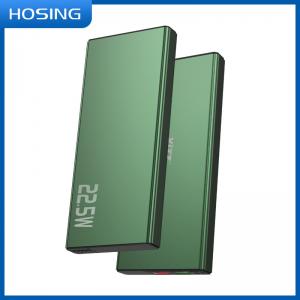
Add to Cart
Green Metal Shell 22.5W Portable Powerbank For All Kinds Phone
Portable charging Power bank with 22.5W output power and metal shell for all kind of phone
| Material: | Metal shell |
| Capacity bettery: | 10000mAh |
| Size: | 141*69*16mm |
| Led display | YES |
| Micro/Type-C Input: | 5V-2A 9V-2A 12V-1.5A |
| USB1(QC3.0)/Type-C(PD) Output: | 5V-3A 9V-2A 12V-1.5A |
| USB 2 Output: | 5V-2.1A |
| Wireless | No |
| Packaging | Retail package with cable |
| Battery: | Lithium-Polymer |
| Compatibility: | Mobile phone/ Tablet charging |
| 1.QC3.0+PD3.0, support dual ports fast charging output. | |
| 2.Can fit all kind of mobile phone | |
| 3.Dual inputs and four outputs, charging 4 devices at the same time. | |
| 4.LED screen light, battery capacity display. | |
Power bank
It is a portable charger that can be carried with you, can store electrical energy by itself, and is mainly used to charge consumer electronic products (such as wireless phones, laptops) such as handheld mobile devices. It is especially used in the absence of external power supply occasion. Its main components include: a battery used for electrical energy storage, a circuit for stabilizing output
voltage (DC-DC converter), and a charger circuit for charging the built-in battery. There are very few mobile power sources without a charging circuit, but they are almost extinct.
Energy storage (battery)
In order to supply power to other devices without an external power supply, the mobile power supply needs a battery for energy storage. Most mobile power sources use lithium-ion batteries (Li-ion) or lithium-ion polymer batteries (Li-PO). A small number of mobile power sources use nickel-metal hydride batteries (Ni-MH). There are also some early mobile power sources. Use the battery once.
Lithium-ion batteries (Li-ion) or lithium-ion polymer batteries (Li-PO) have the highest energy density in terms of weight or volume, that is, the lightest and smallest. In addition, lithium-ion/ion polymer batteries are more efficient during charging and discharging (less energy/electricity is wasted). But the price is also the highest among these batteries, and because overcharge or overdischarge can easily cause permanent damage to the battery, a more sophisticated electronic circuit is required to control the charge and discharge.
Since lithium ion/ion polymer batteries will spontaneously ignite at high temperatures, safety and stability have become extremely important requirements. A reliable safety protection circuit is required to prevent any over-temperature conditions from appearing.

